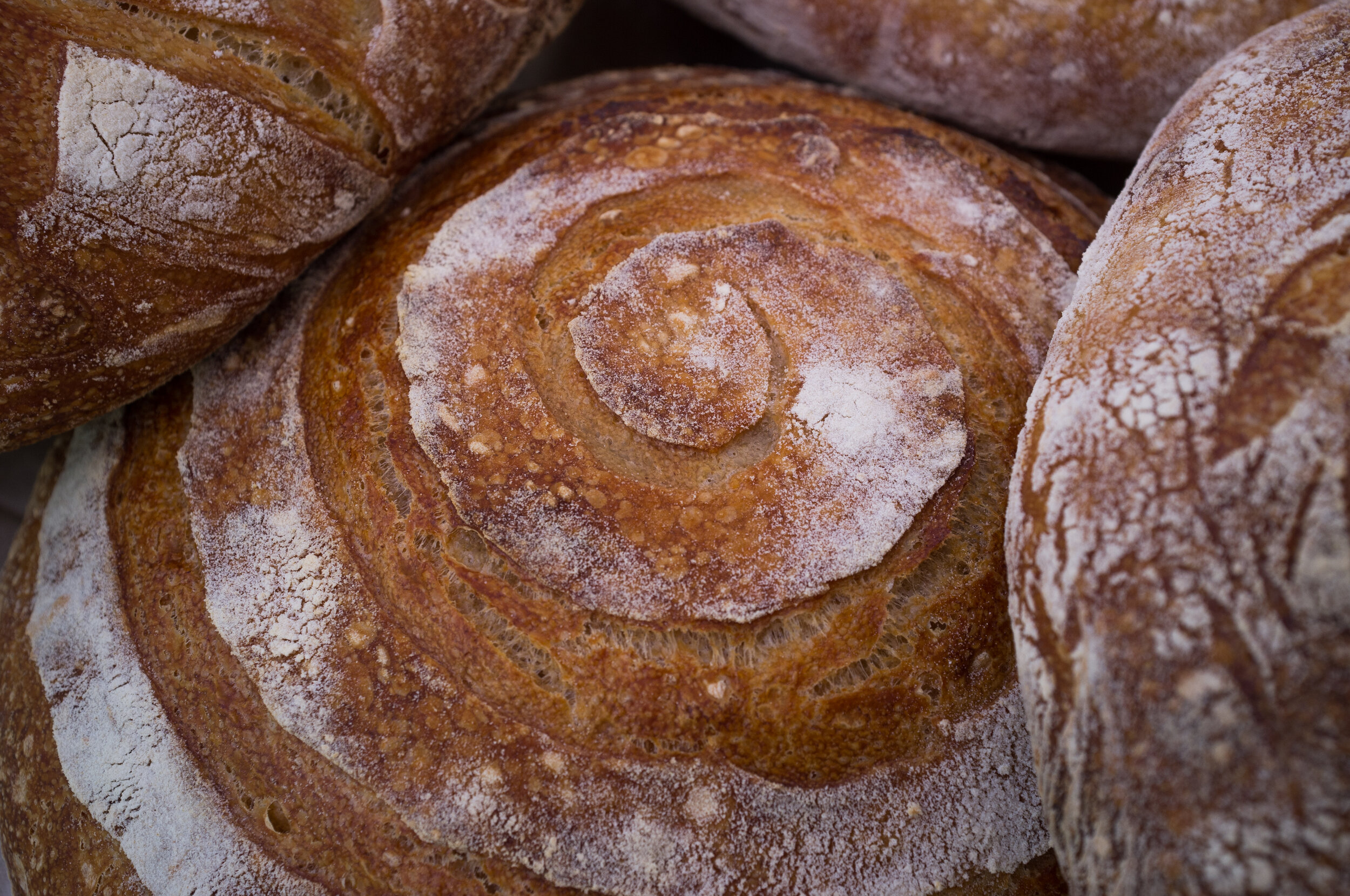Sourdough Bread With an Abundance of Health Benefits
Our bread is a blend of of 3-6 flours consisting of ancient, heritage and Modern varieties that provide an abundance of protective health benefits, found primarily in the germ and bran.
10 reasons why whole grains are healthy and protective:
High in vitamins: B vitamins, including niacin, thiamine, and folate (Hu, F. 2016).
High in Minerals: zinc, iron, magnesium, and manganese (Hu, F. 2016).
High protein content: Average of 13.04 g per 100 g serving (USDA ARS, 2021).
Rich in insoluble fiber for improved fecal bulking, satiety, and viscosity (Fardet, A., 2010).
Rich prebiotic source of soluble carbohydrates (resistant starch) that promote "good" symbiotic gut microbes (Slavin, J., 2010) and aid in production of short chain fatty acids (SCFA) that maintain a balanced gut microflora. (Tan, J 2014).
Lowers risk of diabetes and obesity, including risk of cancers such as colon and breast cancer (Riccardi G et al. 2008).
In a coronary artery disease (CAD) study of patients given whole wheat diets (vs refined white rice flour), serum concentrations of glucose and insulin decreased by 24% and 14%, respectively (Jang et al. 2001).
Reduces lipid (fat) degradation and free radicals that can cause damage to DNA and other parts of human cells (Jang et al. 2001).
High antioxidant activity: phytic acid, lignans, ferulic acid, and sulfur compounds, similar to fruits and vegetables (Decker, E. et al., 2002).
Rich source of plant-based phytochemicals: polyphenols, stanols, and sterols known to reduce serum cholesterol (Zhu Y and Sang S., 2017).
Our bread flour retains most of the bran and is high in both soluble and insoluble fiber. Our foundation flour is Bay State Milling’s HealthSense™ High Fiber Wheat Flour, with 10x more soluble “resistant” fiber (amylose) than common refined white flours.
Approximate fiber and protein contents per 30 gram serving are given along with flour blends in our Menu.
The nutrition data for Organic Whole Grain Spelt used in our starter culture and flour mixture, is given below:
Whole Grain Spelt Nutritional Facts
per 32.1 g serving size*:
Fiber: > 3.0 grams or 12.25% of the Daily Value (DV) – % of amount needed daily.
Protein: > 4.64 grams or 9.3% of the DV
Calories: 116.5 kcal
Carbs: 22.72 grams
Fat: 0.81g
Selenium: 3.03 µg
Folate: 12 µg
Thiamine: 0.1 mg
Sodium: <0.80 mg
Zinc. 1.15 mg
Copper: 0.17 mg
Manganese: : 0.94 mg
Niacin: 1.75 mg
Iron: 1.21 mg
*Source:
References:
1. Decker, E. et al. 2002, Whole grains as a source of antioxidants, Cereal Foods World; St. Paul Vol. 47, Iss. 8, (Sep/Oct 2002): 370.
2. Fardet, A., 2010, New hypotheses for the health-protective mechanisms of whole-grain cereals: what is beyond fibre? Nutr Res Rev. 2010 Jun;23(1):65-134. doi: 10.1017/S0954422410000041. Epub 2010 Jun 22. PMID: 20565994.
3. Hu, F., 2016, The Nutrition Source, What Should I Eat?, Whole Grains, T.H. Chan School of Public Health.
4. Jang, Y. et al., Consumption of Whole Grain and Legume Powder Reduces Insulin Demand, Lipid Peroxidation, and Plasma Homocysteine Concentrations in Patients With Coronary Artery Disease, Randomized Controlled Clinical Trial, Arterioscler Thromb Vasc Biol., 21:2065-2071.
5. Riccardi G et al., 2008, Role of glycemic index and glycemic load in the healthy state, in prediabetes, and in diabetes, Am J Clin Nutr., 269S-274S. doi: 10.1093/ajcn/87.1.269S. PMID: 18175767.
6. Slavin, J.L. et al. ,1999, Plausible mechanisms for the protectiveness of whole grains. Am J Clin Nutr. 1999 Sep;70(3 Suppl):459S-463S. doi: 10.1093/ajcn/70.3.459s. PMID: 10479218.
7. McKenzie, T. J. et al., 2014, The role of short-chain fatty acids in health and disease. Adv Immunol. 2014;121:91-119. doi: 10.1016/B978-0-12-800100-4.00003-9. PMID: 24388214.
8. U.S.D.A., Agricultural Research Service, 2021, FoodData Central, (Whole Grain), 2021.
9. Zhu Y and Sang S., 2017, Phytochemicals in whole grain wheat and their health-promoting effects, Mol Nutr Food Res. 2017 Jul;61(7). doi: 10.1002/mnfr.201600852. Epub 2017 Mar 17. PMID: 28155258.

